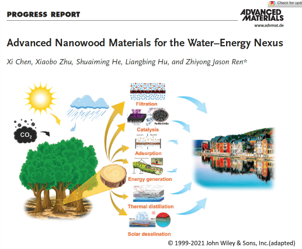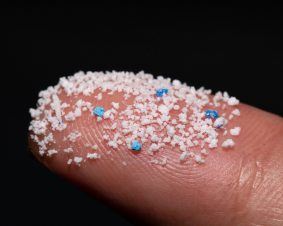 >
Spotlight September 2021: Wood, the raw material of the future?
>
Spotlight September 2021: Wood, the raw material of the future?
One of the greatest challenges facing humanity is to produce clean drinking water under the given circumstances of global warming, population growth and increasing littering. In September, we would like to present a review article that believes one approach to solve this problem is the use of nanoscale wood. In the review, “Advanced Nanowood Materials for the Water-Energy Nexus,” published in the journal Advanced Materials, methods for using wood for water treatment are outlined based on the structure of wood, bottom up or top down. Using the approaches described, wood can be used for water purification, desalination, or chemical removal.
Many examples are shown of how the basic building block of wood, cellulose (a natural polymer), can be processed into nanofibers or polymer matrices, enabling filtration of ultra-small particles.
In contrast, top-down approaches preserve the fundamental structure of wood. For example, naturally occurring channels and mesopores open up the possibility of binding chemicals or applying catalysts. Research with palladium, titanium dioxide, or iron oxide nanoparticles applied to wood showed very good separation of chemicals from water. By chemically modified wood, it was possible to selectively remove copper ions, separate oils and organic solvents, or filter out heavy metals from water.
Wood is an indispensable, climate-neutral raw material due to its ability to bind CO2. In combination with nanoparticles, it may be possible in the future to extend the versatile properties of wood and thus provide a solution approach to water scarcity and environmental pollution.
Original publication:
Chen, X. et al (2021) Advanced Nanowood Materials for the Water–Energy Nexus. Advanced Materials, 33(28), 2001240. doi.org/10.1002/adma.202001240

Weitere Spotlights
Spotlight June 2022: From small to clever – What does the future hold for the safety and sustainability of advanced materials?
The smallest particles in materials research, nanoparticles, have occupied us intensively for more than 20 years to elucidate and further investigate their safety for humans and the environment. Now, however, the development is going from “small = nano” to “clever = advanced”, as discussed in a contribution by international scientists. Thereby, it is a great […]
Read moreSpotlight January 2021: Nanoplastics challenge – How to improve tracking of nanopolystyrene distribution in the environment.
In January, we present a paper published in the Nature Journal communications materials. The article focuses on the development of a new detection method of nanopolystyrene. The method not only makes it possible to detect nanoplastics in the environment for the first time, but also to determine their accumulation in plants and animals. Nanoplastics, which […]
Read moreSpotlight August 2020: The nanoGRAVUR Grouping approach
In August, we would like to present a paper of the German BMBF project nanoGRAVUR. nanoGRAVUR dealt from 2015-2018 with the grouping of nanostructured materials with regard to occupational safety, consumer and environmental protection and risk mitigation. The approach is now described by the project partners in this paper.Due to the variety of synthetic nanomaterials and the numerous modifications (differences in size, shape, chemical composition and surface functionalization), the effort required to investigate effects and behaviour within the framework of regulatory requirements is…
Read moreSpotlight March 2023: How can photovoltaics be made safe and sustainable?
Conventional photovoltaic systems often have only low efficiency, i.e. only a fraction of the solar energy is converted into electrical energy and made usable. For this reason, research is being conducted into innovative materials that can significantly increase the energy yield and thus also enable more electrical energy to be generated from renewable sources. However, […]
Read more


